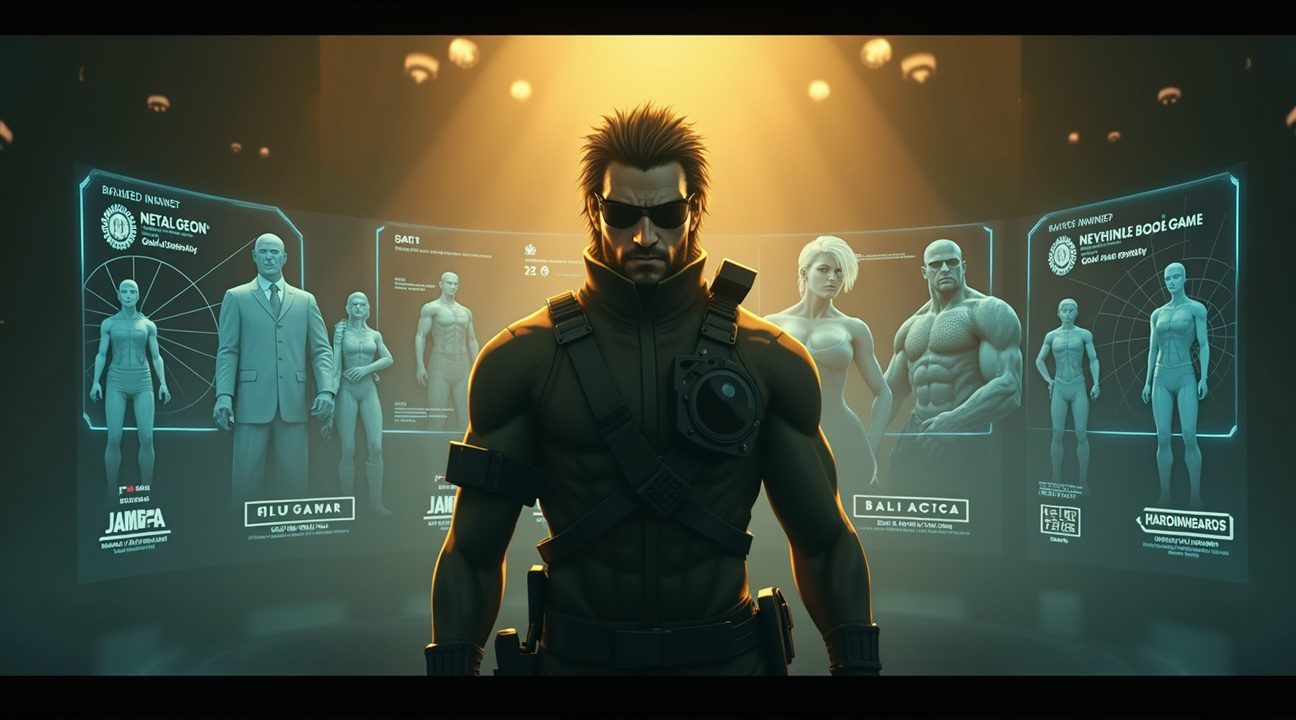The Metal Gear Solid franchise stands as one of gaming’s most transformative achievements, revolutionizing the industry through its groundbreaking blend of cinematic storytelling and innovative stealth gameplay since its debut in 1998.
With over 53 million units sold worldwide and an exceptional 94/100 Metacritic score for the original title, the series has consistently set new standards for interactive entertainment while influencing countless developers across multiple generations.
Key Takeaways
- Record-breaking commercial and critical success – Metal Gear Solid achieved a 94/100 Metacritic score, sold over 7 million copies globally, and shipped 12 million demos worldwide, establishing it as one of the highest-rated games in history.
- Genre-defining stealth mechanics – The franchise created the “sneak-’em-up” genre, fundamentally changing how developers approach stealth gameplay by rewarding strategic thinking and environmental awareness over direct confrontation.
- Cinematic storytelling pioneer – Hideo Kojima’s vision transformed gaming through movie-quality production values, extended cutscenes, and complex narratives that proved video games could deliver sophisticated storytelling alongside engaging gameplay.
- Extensive timeline spanning five decades – The series presents an intricate alternate history from 1964 to the near-future across 11 mainline games, with Big Boss and Solid Snake serving as central figures connecting multiple generations of conflict.
- Industry recognition and lasting influence – The franchise has earned prestigious awards including BAFTA nominations and wins at The Game Awards, while its innovations in character development, moral complexity, and environmental storytelling continue to influence modern game design.
Metal Gear Solid’s Record-Breaking Impact on Gaming History
Metal Gear Solid transformed the gaming landscape in 1998, setting standards that continue to influence game design today. I can confidently say this title didn’t just enter the market—it redefined what players expected from interactive entertainment. The game achieved an exceptional average score of 94/100 on Metacritic, establishing itself as one of the highest-rated titles in gaming history.
The commercial success proved equally impressive. Metal Gear Solid sold over seven million copies globally, while an astounding 12 million demos were shipped worldwide, demonstrating unprecedented interest before the full release. These numbers reflected the industry’s recognition that something special was happening with Hideo Kojima’s stealth masterpiece.
Critical Acclaim and Genre Innovation
PlayStation Official Magazine – UK didn’t hold back in their assessment, declaring Metal Gear Solid “the best game ever made.” GMR reinforced this sentiment by calling it a “cinematic classic,” highlighting how the title successfully bridged the gap between traditional gaming and cinematic storytelling. These accolades weren’t just marketing hyperbole—they represented genuine industry recognition of the game’s groundbreaking approach.
The franchise’s influence extends far beyond its initial release. Metal Gear Solid introduced what became known as the ‘sneak-’em-up’ genre, fundamentally changing how developers approached stealth mechanics. Rather than relying on direct confrontation, the game encouraged players to think strategically, use environmental awareness, and employ creative problem-solving techniques. This approach established foundational standards for stealth and adventure games that continue to shape titles today, much like how other franchises have evolved their own unique approaches in recent years, including Call of Duty’s latest installments.
The broader Metal Gear franchise has accumulated over 53 million units sold worldwide as of 2021, proving that the formula Kojima perfected resonated with multiple generations of players. This sustained success demonstrates how the original’s innovations created lasting appeal that transcended typical gaming trends. The cinematic presentation, complex narrative structure, and innovative stealth mechanics became blueprints that influenced countless developers.
Modern gaming owes much to Metal Gear Solid’s pioneering approach. The title proved that games could deliver sophisticated storytelling while maintaining engaging gameplay mechanics. Its influence can be seen in contemporary titles that blend narrative depth with strategic gameplay, from indie stealth games to major studio productions that continue pushing boundaries in interactive entertainment.
From MSX2 to Modern Gaming: The Evolution of Metal Gear
I can trace the fascinating journey of Metal Gear back to 1987, when Hideo Kojima first introduced this groundbreaking stealth-action experience on the MSX2 computer. Konami’s decision to develop and publish this ambitious project marked the beginning of what would become one of gaming’s most influential franchises. The original Metal Gear established a completely new approach to action gaming that prioritized cunning and strategy over brute force.
The Stealth Revolution That Changed Gaming
The franchise’s emphasis on stealth action gameplay created ripple effects throughout the entire gaming industry. Rather than encouraging players to charge into combat situations, Metal Gear rewarded patience, observation, and tactical thinking. This innovative approach influenced countless developers and helped establish stealth mechanics as a legitimate genre. Games today still draw inspiration from the foundation Kojima laid with his original vision, much like how modern warfare titles continue to evolve their tactical elements.
I’ve watched as the stealth genre has expanded far beyond its humble MSX2 origins. The core principles Kojima established – avoiding detection, using environmental awareness, and thinking creatively about problem-solving – have become standard elements in many contemporary games. This influence extends to unexpected places, from action-adventure titles to even sandbox experiences that incorporate stealth mechanics.
Kojima’s Narrative and Cinematic Innovation
Kojima built his reputation by pushing narrative ambition to unprecedented levels within the gaming medium. His approach to storytelling broke conventional boundaries by embracing cinematic techniques that transformed how players experienced interactive entertainment. The franchise became known for its extended cutscenes, complex philosophical themes, and intricate plot structures that rivaled major motion pictures.
The innovative game design principles Kojima implemented went far beyond surface-level mechanics. He consistently challenged player expectations through unconventional approaches to gameplay interaction.
- Breaking the fourth wall
- Characters addressing players directly
- Incorporating real-world elements into the gaming experience
These bold choices influenced how other developers approached narrative integration in their own projects.
Modern gaming continues to reflect Metal Gear’s impact through sophisticated storytelling techniques and player engagement strategies. The franchise demonstrated that video games could tackle serious subjects while maintaining entertainment value. This balance between intellectual depth and engaging gameplay has inspired everything from independent projects to major studio productions. Even entertainment adaptations have drawn from this approach, as seen in projects like game-to-screen transitions that attempt to capture similar narrative complexity.
The technical achievements of the Metal Gear series also pushed hardware capabilities to their limits. Each installment showcased what was possible on its respective platform, from the MSX2’s limited resources to the advanced processing power of modern consoles.
- Metal Gear MSX2 – Introduced core stealth mechanics
- Metal Gear Solid (PS1) – Revolutionized cinematic storytelling
- Metal Gear Solid 3: Snake Eater – Mastered historical immersion
- Metal Gear Solid 4: Guns of the Patriots – Pushed console capabilities
- Metal Gear Solid V – Embraced open-world design
This commitment to technical excellence encouraged other developers to explore creative solutions for hardware limitations and optimize their own projects more effectively.
The franchise’s evolution from its 1987 MSX2 debut to contemporary gaming platforms demonstrates how visionary design can transcend technological constraints. Kojima’s work proved that innovative gameplay concepts and compelling narratives could overcome hardware limitations to create lasting cultural impact. This legacy continues to influence how developers approach game design, from independent creators experimenting with franchise expansion to major studios developing anticipated sequels.
The stealth-action formula Metal Gear established remains relevant decades later because it tapped into fundamental aspects of human psychology – the thrill of avoiding detection, the satisfaction of outsmarting opponents, and the engagement that comes from strategic thinking. These timeless elements ensure that Kojima’s original vision continues to resonate with new generations of players while inspiring countless developers to push their own creative boundaries.

An Alternate History Spanning Decades: The Complex Metal Gear Timeline
The Metal Gear universe presents an intricate alternate history that stretches across nearly five decades, weaving together Cold War tensions, technological advancement, and philosophical questions about warfare. This expansive narrative spans 11 mainline games, each contributing essential pieces to a chronological puzzle that begins in 1964 and extends into a speculative near-future.
The Chronological Journey Through Time
Understanding the Metal Gear timeline requires following its chronological order rather than release dates. The saga begins with Metal Gear Solid 3: Snake Eater in 1964, establishing the foundation during the height of Cold War paranoia. This starting point is particularly compelling because it sets up the ideological conflicts that echo throughout the entire series.
The timeline progression reveals a carefully constructed narrative:
- Metal Gear Solid 3: Snake Eater (1964) – The origin story that establishes Big Boss’s legend
- Metal Gear Solid: Portable Ops (1970) – Exploring the aftermath of Operation Snake Eater
- Metal Gear Solid: Peace Walker (1974) – Big Boss’s descent into moral ambiguity
- Metal Gear Solid V: Ground Zeroes (1975) – The dramatic turning point
- Metal Gear Solid V: The Phantom Pain (1984) – Big Boss’s transformation into the series’ primary antagonist
- Metal Gear (1995) – The original conflict between mentor and student
- Metal Gear 2: Solid Snake (1999) – The definitive confrontation
- Metal Gear Solid (2005) – Shadow Moses Island incident
- Metal Gear Solid 2: Sons of Liberty (2007–09) – Information control and digital manipulation
- Metal Gear Solid 4: Guns of the Patriots (2014) – The final chapter of Snake’s story
- Metal Gear Rising: Revengeance (near-future) – A cybernetic epilogue
Big Boss serves as the central figure connecting these disparate time periods. His character arc transforms from noble soldier to legendary villain, creating the thematic backbone for the entire franchise. The prequel games explore his gradual fall from grace, while later titles deal with the consequences of his actions and ideology.
Solid Snake emerges as the other crucial narrative anchor, representing the next generation’s struggle with the legacy left behind. The relationship between these two characters — mentor and student, father and son, hero and villain — creates dramatic tension that drives multiple storylines across decades.
The series demonstrates remarkable consistency in its alternate history approach. Major world events unfold differently due to the influence of various Metal Gear projects and the shadowy organizations behind them. Cold War politics, the nature of warfare, and technological advancement all follow altered trajectories that feel both familiar and distinctly different from our reality.
Each game contributes unique elements to this overarching narrative while maintaining thematic consistency. The early Cold War entries focus on espionage and political intrigue, while later games explore themes of information control, genetic manipulation, and the nature of identity. Recent gaming developments, much like how Call of Duty continues evolving its storytelling, show how franchises can maintain relevance across generations.
The genius of the Metal Gear timeline lies in how it rewards both casual players and dedicated fans. Someone can enjoy any single game as a standalone experience, yet those who follow the complete chronological sequence discover deeper meanings, character connections, and plot revelations that span decades. References and callbacks create a rich tapestry of interconnected stories that enhance each individual entry.
The franchise’s approach to time manipulation also deserves recognition. By jumping between different eras, the series explores how past actions influence future events, how legends become myths, and how technology shapes warfare. This non-linear storytelling approach allows players to witness both the creation of problems and their eventual resolution, creating a unique narrative structure rarely seen in gaming.
Understanding this complex timeline enhances appreciation for the series’ ambitious scope and thematic depth. The Metal Gear universe doesn’t just tell a story — it creates an entire alternate history that challenges players to think critically about war, technology, and human nature across multiple generations.
Industry Recognition: Awards That Define Excellence
The Metal Gear Solid franchise has consistently earned recognition from prestigious gaming institutions, establishing itself as a benchmark for excellence in interactive entertainment. This recognition spans decades and showcases the series’ lasting impact on the industry.
Landmark Achievements and Critical Acclaim
The original Metal Gear Solid (1998) set the standard for industry recognition that would follow throughout the franchise. The game captured the Excellence Award for Interactive Art at the 1998 Japan Media Arts Festival, demonstrating its innovative approach to storytelling and visual design. At E3 1998, it claimed the Best Console Game award, while the Academy of Interactive Arts & Sciences recognized its quality with nominations for Game of the Year and Console Action Game of the Year in 1999.
These early accolades established the franchise’s reputation for pushing creative boundaries. Metal Gear Solid V: The Phantom Pain (2015) continued this tradition of excellence, earning an impressive 7 wins and 17 nominations across various gaming awards ceremonies. The game received BAFTA Games Award nominations in three significant categories:
- Artistic Achievement
- Audio Achievement
- Best Game
The 2015 Game Awards honored The Phantom Pain with wins for:
- Best Action/Adventure Game
- Best Score/Soundtrack
The SXSW Gaming Awards followed suit in 2016, presenting the game with the Excellence in Gameplay award. Additionally, the Golden Joystick Awards recognized it with the Critics Choice award in 2015.
This pattern of recognition reflects the franchise’s ability to innovate across multiple gaming elements simultaneously. From groundbreaking stealth mechanics to cinematic storytelling techniques, each entry has pushed the medium forward in meaningful ways. The consistent acknowledgment from industry peers and critics demonstrates how modern gaming franchises can maintain relevance across multiple console generations.
The awards showcase the series’ technical achievements alongside its artistic vision. Sound design, visual presentation, and gameplay innovation have all received individual recognition, proving that Metal Gear Solid‘s success stems from attention to detail across every aspect of game development. These accolades serve as testament to the franchise’s influence on contemporary game design and its role in shaping player expectations for narrative-driven action games.

Complete Franchise Journey: Main Games and Beyond
I’ve witnessed the Metal Gear franchise evolve from its humble 8-bit origins into one of gaming’s most influential stealth-action series. The journey begins with Metal Gear in 1987, where Hideo Kojima first introduced players to tactical espionage action on the MSX2 computer. This groundbreaking title established the foundation for what would become a legendary franchise.
Core Series Evolution
The franchise gained momentum with Metal Gear 2: Solid Snake in 1990, which refined the stealth mechanics and narrative depth. However, it was Metal Gear Solid in 1998 that truly revolutionized gaming. This PlayStation exclusive brought cinematic storytelling and complex themes to mainstream audiences, setting new standards for narrative-driven games.
Metal Gear Solid 2: Sons of Liberty arrived in 2001, pushing the boundaries of what players expected from sequels. Kojima’s bold narrative choices and technical achievements on PlayStation 2 cemented the series’ reputation for innovation. Metal Gear Solid 3: Snake Eater followed in 2004, taking the series back to the Cold War era and delivering what many consider the franchise’s emotional peak.
The portable entries expanded the universe further:
- Metal Gear Solid: Portable Ops (2006) brought console-quality gameplay to PSP.
- Metal Gear Solid 4: Guns of the Patriots (2008) provided a technological showcase for PlayStation 3.
- Metal Gear Solid: Peace Walker (2010) proved that handheld entries could match their console counterparts in depth and quality.
Modern Era and Expanded Universe
The franchise took an unexpected turn with Metal Gear Rising: Revengeance in 2013, shifting from stealth to high-octane action. This spin-off demonstrated the series’ versatility while maintaining its core identity. Metal Gear Solid V arrived in two parts:
- Ground Zeroes (2014) served as a prologue,
- The Phantom Pain (2015) concluded Kojima’s direct involvement with the series.
Beyond gaming, the Metal Gear universe has expanded significantly. Comic adaptations have explored storylines between games, while novels have delved deeper into character backgrounds and lore. The upcoming Metal Gear Solid movie adaptation promises to bring the franchise’s cinematic qualities to theaters, potentially introducing new audiences to this rich universe.
Each entry has contributed unique elements to the franchise’s DNA, from revolutionary stealth mechanics to philosophical storytelling. The series has consistently pushed technical boundaries while addressing themes of war, politics, and human nature. Much like how other franchises explore adaptation opportunities, Metal Gear’s expansion into different media reflects its enduring cultural impact and the depth of its source material.
https://www.youtube.com/watch?v=L5IVOs5Pxh8
The Lasting Legacy of Cinematic Gaming
Metal Gear Solid fundamentally transformed how video games approach storytelling, establishing a blueprint that countless developers still follow today. The series brilliantly weaves together complex narratives that tackle war’s psychological toll, political corruption, and technology’s double-edged nature, creating experiences that resonate far beyond traditional gaming boundaries.
Hideo Kojima’s masterpiece introduced the concept of cinematic gaming by seamlessly blending movie-quality production values with interactive gameplay elements. Extended cutscenes, professional voice acting, and dramatic musical scores became hallmarks that elevated the medium from simple entertainment to a legitimate art form. This approach influenced an entire generation of game developers who recognized that players craved more than just button-mashing action.
Cultural Impact Through Character Development
The franchise’s most significant achievement lies in its character development and moral complexity. These elements have shaped gaming culture in several important ways:
- Solid Snake emerged as gaming’s first truly complex protagonist, dealing with PTSD and questioning his purpose as a soldier
- Boss battles became psychological explorations rather than simple combat encounters, with villains like Psycho Mantis breaking the fourth wall
- Supporting characters received extensive backstories that added emotional weight to every interaction
- Voice actors like David Hayter became celebrities within gaming communities, proving that performance quality matters in interactive media
This character-driven approach inspired similar depth in modern franchises, from Cyberpunk 2077 to narrative-heavy series that prioritize storytelling alongside gameplay mechanics.
Recent releases demonstrate the series’ continued relevance to contemporary audiences. The Master Collection Vol. 1 remaster introduced classic titles to PlayStation 5 and modern platforms, while the upcoming Snake Eater remake promises to bring cutting-edge visuals to one of gaming’s most beloved entries. These projects prove that Kojima’s vision remains compelling decades after the original releases.
The franchise’s influence extends beyond gaming into broader entertainment culture. References appear in films, television shows, and other media, while concepts like stealth gameplay and moral ambiguity have become standard elements in action games. Even titles like Call of Duty Modern Warfare 3 incorporate narrative techniques pioneered by Metal Gear Solid.
Today’s developers continue studying the series’ approach to environmental storytelling, where every detail serves the larger narrative purpose. This attention to world-building has influenced everything from independent titles to major AAA productions, proving that Metal Gear Solid‘s legacy extends far beyond its original PlayStation exclusivity into the foundation of modern interactive entertainment.
Sources:
Wikipedia, “Metal Gear”
Wikipedia, “Metal Gear Solid (1998 video game)”
MindOnMap, “Metal Gear Timeline: Where Should You Start in the Game”
IMDb, “Awards – Metal Gear Solid V: The Phantom Pain”
BeyondVideoGaming, “Metal Gear Solid Timeline – Everything in Chronological Order”
IMDb, “Awards – Metal Gear Solid (Video Game 1998)”
YouTube, “The Complete METAL GEAR SOLID Timeline Explained!”


